Asturien |
|
|
|
| Übersicht – Contents: | |
Diese Seite ist Teil des Projektes
Asturien |
|
|
|
| Übersicht – Contents: | |
Flagge – Flag: |
|
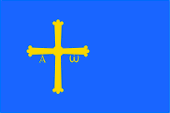 |
Flagge von Asturien |
| historische und andere Flaggen – historical and other Flags: | |
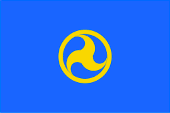 |
1976–1981, Conceyu Nacionalista Astur, |
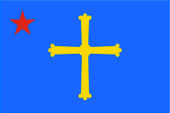 |
1982–1992, Ensame Nacionalista Astur, |
| Die heutige Flagge Asturiens wurde am 05.10.1981 eingeführt. Sie ist einfarbig Hellblau und zeigt in Richtung des Flaggenmastes verschoben ein goldenes christliches Kreuz, Siegeskreuz genannt. An dessen waagerechtem Balken hängen links und rechts die griechischen Buchstaben Alpha und Omega. Das Aussehen der Flagge ist geregelt im Autonomiestatut von Asturien aus dem Jahr 1981, im Jahre 1999 in Autonomiestatut des Fürstentums Asturien umbenannt, wobei die Farben nur als Blau und Gelb erwähnt werden. Ebenso regelt das Gesetz 4/1990 vom 19.12.1990 das Aussehen der Flagge und benennt sogar Pantone-Farbtöne (Gelb = Pantone 109, Blau = Pantone 829), wobei ein Fehler unterlaufen sein dürfte. Ein Farbton Pantone 829 ist nicht zu ermitteln. Das Siegeskreuz ist ein sehr altes Symbol, fast schon eine Reliquie. Es wurde im Jahre 722 während der Schlacht von Covadonga gegen die Araber dem siegreichen christlichen Heer vorangetragen. Im Jahr 908 befahl der asturische König Alfons III. (der Große), dass das ursprüngliche Holzkreuz aus Eichenholz mit Gold und Edelsteinen verkleidet werden sollte. Heute wird es in der Heiligen Kammer der Kathedrale von Oviedo aufbewahrt. Der Ursprung der heutigen Flagge liegt in einer Rekonstruktion aus dem Jahre 1785. Aus der Frühzeit des Landes, das im 11. Jahrhundert im Königreich Leon aufging, sind keine heraldischen Symbole überliefert. Eine der ersten Erwähnungen von Landessymbolik stammt von Lazaro Díaz del Valle aus dem 17. Jahrhundert. Er beschreibt jedoch das goldene Siegeskreuz auf rotem Grund. Das Hellblau der Flagge wurde wahrscheinlich dem Wappen der Stadt Oviedo entnommen, möglicherweise weil Asturien im 8. und 9. Jahrhundert "Königreich von Oviedo" genannt wurde. Das Wappen von Oviedo zeigt ein goldenes Siegeskreuz auf hellblauem Grund flankiert von zwei Engeln. Die Farbe Blau steht für die Jungfrau Maria. Die Buchstaben Alpha und Omega beziehen sich auf die Bibel: "Und er sprach zu mir: Es ist geschehen. Ich bin der Anfang und das Ende. Ich will den Durstigen geben von dem Brunnen des lebendigen Wassers umsonst. Wer überwindet, der wird es alles ererben, und ich werde sein Gott sein, und er wird mein Sohn sein." (Offenbarung 21:6-7). Mit der Verlagerung der Hauptstadt nach Leon und der Vereinigung von Galicien, Asturien und Leon zum Königreich Leon konnte sich wahrscheinlich keine eigene Heraldik entwickelt. Diese wurde erst mit der entstehenden Autonomiebewegung wieder belebt, wobei man auf die Rekonstruktion von 1785 zurückgriff. Es gibt eine Variante der Flagge von Asturien, die das Kreuz genau in der Mitte des Flaggentuches zeigt. Sie ist zu verwenden ist, wenn die Flagge nicht an einem Fahnenmast hochgezogen wird, sondern dekorativ eine Wand, einen Tisch oder ein Rednerpult schmückt. Von der Flagge mit dem Richtung Mast verschobenen Kreuz gibt es eine Variante, die das Kreuz mit Edelsteinen besetzt zeigt, so wie das Original des Kreuzes in der Heiligen Kammer. Diese Variante ist als Zeremonialflagge gedacht und für besondere Anlässe vorgesehen. Politische und kulturelle Gruppen welche die Identität von Asturien erhalten und fördern wollen, oder gar die Unabhängikeit des Landes wünschen oder wünschten, verwenden auch die hellblaue Flagge Asturiens, ergänzt um eigene Symbolik, wobei die linken Gruppen durch den roten Stern zu erkennen sind. Die "Conceyu Nacionalista Astur" zeigte eine goldene Triskele in der Mitte. Die Triskele ist ein nordisches Motiv, das in Astrurien möglicherweise auf die Westgoten zurückgeht. Die Triskele ist ein Dreiecksknoten, der die Dreiheit der nordischen Götter Wodan, Donar und Tyr (Odin, Thor und Ziu) verkörpert, aber seit der Christianisierung auch für die Heilige Dreifaltigkeit steht. |
The current flag of
Asturias was introduced on 5th of October in 1981. It is monochrome light blue and shows
a golden Christian cross, called the Victory Cross, shifted towards the
flagpole. The Greek letters Alpha and Omega hang from its horizontal bar on
the left and right. The appearance of the flag is regulated by the Statute of Autonomy of Asturias of 1981, renamed in 1999 the Statute of Autonomy of the Principality of Asturias, where the colours are only mentioned as blue and yellow. Likewise, Law 4/1990 of 19th of December in 1990 regulates the appearance of the flag and even names Pantone shades (yellow = Pantone 109, blue = Pantone 829), although a mistake may have been made. A Pantone 829 hue cannot be determined. The Victory Cross is a very old symbol, almost a relic. It was carried in front of the victorious Christian army during the battle of Covadonga against the Arabs in 722. In 908, the Asturian king Alfonso III (the Great) ordered that the original wooden cross made of oak be covered with gold and precious stones. Today it is kept in the Holy Chamber of Oviedo Cathedral. The origin of the present flag lies in a reconstruction from 1785. No heraldic symbols have survived from the early days of the country, which was absorbed into the Kingdom of Leon in the 11th century. One of the first mentions of land symbolism comes from Lazaro Díaz del Valle in the 17th century. However, he describes the golden Victory Cross on a red background. The light blue of the flag was probably taken from the coat of arms of the city of Oviedo, possibly because Asturias was called the "Kingdom of Oviedo" in the 8th and 9th centuries. The coat of arms of Oviedo shows a golden victory cross on a light blue background flanked by two angels. The colour blue represents the Virgin Mary. The letters alpha and omega refer to the Bible: "And he said unto me, It is done. I am the beginning and the end. I will give to the thirsty of the fountain of living water freely. He that overcometh shall inherit it all, and I will be his God, and he shall be my son." (Revelation 21:6-7). With the transfer of the capital to Leon and the unification of Galicia, Asturias and Leon into the Kingdom of Leon, it was probably not possible to develop a heraldry of their own. This was only revived with the emerging autonomy movement, reverting to the reconstruction of 1785. There is a variant of the flag of Asturias that shows the cross exactly in the centre of the flag cloth. It is to be used when the flag is not raised on a flagpole, but decoratively adorns a wall, table or lectern. There is a variant of the flag with the cross shifted towards the pole, which shows the cross set with precious stones, like the original of the cross in the Holy Chamber. This variant is intended as a ceremonial flag and for special occasions. Political and cultural groups that want to preserve and promote the identity of Asturias, or even want or desire the independence of the country, also use the light blue flag of Asturias, supplemented with their own symbolism, whereby the left-wing groups can be recognised by the red star. The "Conceyu Nacionalista Astur" showed a golden triskele in the centre. The triskele is a Nordic motif, possibly dating back to the Visigoths in Astruria. The triskele is a triangular knot that embodies the trinity of the Norse gods Wodan, Donar and Tyr (Odin, Thor and Ziu), but since christianisation it has also stood for the Holy Trinity. |
| Quelle/Source: Wikipedia (ES), Flags of the World, 1.) www.asturias.es, 2.) www.asturias.es, Volker Preuß | |
Wappen – Coat of Arms: |
|
 |
seit/since 1984, Wappen von Asturien – coat of arms of Asturias, Quelle/Source, nach/by: upload.wikimedia.org |
| Das heutige Wappen Asturiens wurde zuletzt am 27.04.1984 per Gesetz bestätigt. Der Wappenschild ist einfarbig blau und zeigt ein goldenes christliches Kreuz, an dessen waagerechten Balken links und rechts die griechischen Buchstaben Alpha und Omega hängen. Es geht auf das Wappen des Provinzrats von Oviedo aus dem Jahr 1857 zurück und ähnelt dem Wappen der Stadt Oviedo. Das Siegeskreuz ist ein sehr altes Symbol, fast schon eine Reliquie. Es wurde im Jahre 722 während der Schlacht von Covadonga gegen die Araber dem siegreichen christlichen Heer vorangetragen. Im Jahr 908 befahl der asturische König Alfons III. (der Große), dass das ursprüngliche Holzkreuz aus Eichenholz mit Gold und Edelsteinen verkleidet werden sollte. Heute wird es in der Heiligen Kammer der Kathedrale von Oviedo aufbewahrt. Der Ursprung der heutigen Flagge liegt in einer Rekonstruktion aus dem Jahre 1785. Aus der Frühzeit des Landes, das im 11. Jahrhundert im Königreich Leon aufging, sind keine heraldischen Symbole überliefert. Eine der ersten Erwähnungen von Landessymbolik stammt von Lazaro Díaz del Valle aus dem 17. Jahrhundert. Er beschreibt jedoch das goldene Siegeskreuz auf rotem Grund. Das Hellblau der Flagge wurde wahrscheinlich dem Wappen der Stadt Oviedo entnommen, möglicherweise weil Asturien im 8. und 9. Jahrhundert "Königreich von Oviedo" genannt wurde. Die Farbe Blau steht für die Jungfrau Maria. Die Buchstaben Alpha und Omega beziehen sich auf die Bibel: "Und er sprach zu mir: Es ist geschehen. Ich bin der Anfang und das Ende. Ich will den Durstigen geben von dem Brunnen des lebendigen Wassers umsonst. Wer überwindet, der wird es alles ererben, und ich werde sein Gott sein, und er wird mein Sohn sein." (Offenbarung 21:6-7). Rings um das Wappenschild ein lateinischer Spruch: "HOC SIGNO TUETUR PIUS, HOC SIGNO VINCITUR INIMICUS", was übersetzt heißt: "Durch dieses Zeichen wird man göttlich beschützt, durch dieses Zeichen wird der Feind besiegt." Oberhalb des Wappenschildes erscheint die spanische Königskrone. |
The current coat of arms
of Asturias was last confirmed by law on 27th of April in 1984. The coat of
arms is solid blue and shows a golden Christian cross with the Greek letters
alpha and omega hanging from its horizontal bars on the left and right. It
goes back to the coat of arms of the Provincial Council of Oviedo in 1857
and is similar to the coat of arms of the city of Oviedo. The Victory Cross is a very old symbol, almost a relic. It was carried in front of the victorious Christian army in 722 during the battle of Covadonga against the Arabs. In 908, the Asturian king Alfonso III (the Great) ordered that the original wooden cross made of oak be covered with gold and precious stones. Today it is kept in the Holy Chamber of Oviedo Cathedral. The origin of the present flag lies in a reconstruction from 1785. No heraldic symbols have survived from the early days of the country, which was absorbed into the Kingdom of Leon in the 11th century. One of the first mentions of land symbolism comes from Lazaro Díaz del Valle in the 17th century. However, he describes the golden Victory Cross on a red background. The light blue of the flag was probably taken from the coat of arms of the city of Oviedo, possibly because Asturias was called the "Kingdom of Oviedo" in the 8th and 9th centuries. The colour blue represents the Virgin Mary. The letters alpha and omega refer to the Bible: "And he said unto me, It is done. I am the beginning and the end. I will give to the thirsty of the fountain of living water freely. He that overcometh shall inherit it all, and I will be his God, and he shall be my son." (Revelation 21:6-7). Around the escutcheon a Latin saying, "HOC SIGNO TUETUR PIUS, HOC SIGNO VINCITUR INIMICUS," which translates as, "By this sign one is divinely protected, by this sign the enemy is defeated." The Spanish royal crown appears above the escutcheon. |
| Quelle/Source: Wikipedia (ES), Wikipedia (DE), Volker Preuß | |
|
Die autonomen Regionen Spaniens – The autonomous Regions of Spain: Interaktive Landkarte - interactive map |
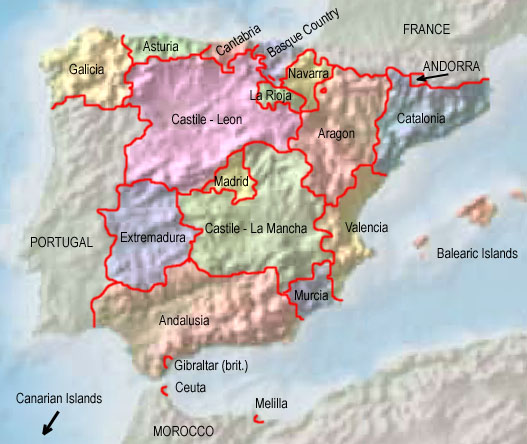 |
| Quelle/Source: Freeware, University of Texas Libraries, modyfied by: Volker Preuß |
|
Karte der historischen Königreiche auf der Iberischen Halbinsel (ca. 1220) – Map of the historical Kingdoms on the Iberian Peninsula (ca. 1220): Interaktive Landkarte - interactive map |
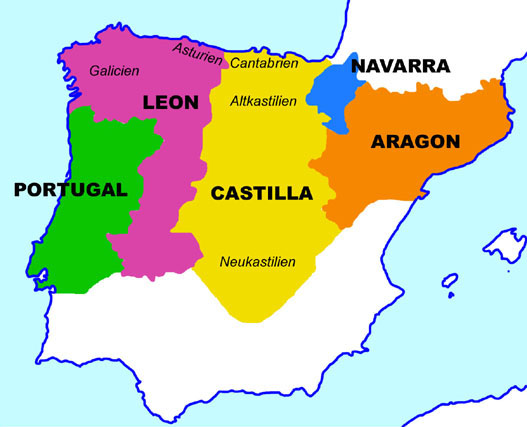 |
| Landkarte/map by: Volker Preuß |
| Zahlen und Fakten – Numbers and Facts: | |
|
|
|
|
|
|
|
|
|
|
|
|
|
|
|
|
|
Frühzeit
· Besiedlung des heutigen Kanatbriens durch das indogermanische Volk der
Kantabrer (lateinisch: Cantabri) ca. 600 v.Chr. · Einwanderung von Kelten und Iberern, Herausbildung der Keltiberer 218–201 v. Chr. · Zweiter Punischer Krieg, das Römische Reich erwirbt die Besitzungen Karthagos in Iberien, Unterwerfung der ganzen Iberischen Halbinsel bis zum Jahre 19 v.Chr., römische Besiedlung, Romanisierung, das heutige Asturien kommt erst 22 v.Chr. zur römischen Provinz Hispania Tarraconensis ca. 400 · Völkerwanderung, Durchzug germanischer Alanen, Sweben und Westgoten, das heutige Asturien wird Teil des Westgotenreiches 711–714 · Vernichtung des Westgotenreichs durch von Nordafrika kommende Araber, die Westgoten ziehen sich nach Asturien und Kantabrien zurück, es gelingt den Arabern nicht Asturien zu erobern 716 · Herzog Pelayo (Pelagius), flieht aus der Gefangenschaft des zu den Arabern loyalen Westgotenkönigs Witiza von Toledo nach Oviedo in Asturien 718 · die Westgoten wählen Pelayo zu ihrem Fürsten 722 · Schlacht von Covadonga, Fürst Pelayo von Oviedo schlägt die Araber, Beginn des Befreiungskrieges der Iberischen Völker gegen die Araber (Reconquista) 739–757 · Herrschaft von Alfons I., verheiratet mit Hermesinde der Tochter von Pelayo, ab 753 König von Oviedo (Asturien) 856 · König Ordoño I. von Oviedo (Asturien) befreit die Stadt Leon von den Moslems und besetzt ganz Galicien 910 · Tod von König Alfons III. von Oviedo, Erbteilung seines Reiches unter seinen Söhnen, sein Sohn Garcia I. wird König von Leon, sein Sohn Ordoño II. wird König von Galizien, sein Sohn Fruela II. erbt Asturien 914 · Tod von König Garcia I., sein Bruder König Ordoño II. von Galizien erbt Leon 914–924 · Herrschaft von König Ordoño II. von Galizien und Oviedo (Asturien) 924 · Tod von König Ordoño II., das Erbe fällt an König Fruela II. von Oviedo (Asturien), er verlegt seine Residenz von Oviedo nach Leon, das Land wird ab jetzt Königreich Leon genannt 931–950 · Herrschaft von König Ramiro II., ein Sohn von Ordoño II., Vereinigung von Galicien, Asturien und Leon unter einer Krone (Königreich Leon), erfolgreiche Kriege gegen die Araber, Ausdehnung des Reiches 1028–1037 · Herrschaft von König Bermudo III. von Leon 1037 · König Bermudo III. von León greift das Königreich Kastilien an, Niederlage und Tod von Bermudo in der Schlacht am Rio Carrión, somit Aussterben der Dynastie Pelayo, König Ferdinand von Kastilien erbt das Königreich Leon, somit sind Kastilien, León, Asturien und Galicien unter einer Krone vereint (Königreich Kastillien-Leon) 1157 · Tod von König Alfons VII. von Kastillien, Erbteilung, Leon wird wieder ein eigenes Königreich 1230 · Leon und Kastillien werden unter König Ferdinand III. von Kastilien wieder unter einer Krone vereinigt, Königreich Kastillien-Leon, Asturien wird ein Fürstentum innerhalb von Kastillien-Leon mit vielen Privilegien 1388 · die Kronprinzen von Kastillien-Leon (später auch von Spanien) nehmen den Titel "Prinz von Asturien" an 1808–1813 · Asturien ist durch französische Truppen besetzt 1820 · Aufhebung der Privilegien 1823 · Wiedereinführung der Privilegien 1833 · die bis dato in Spanien bestehenden Teilkönigreiche und Regionen werden in Provinzen aufgeteilt, das Königreich Asturien in die Provinzen Oviedo und Santander (Kantabrien) 1936–1939 · Spanischer Bürgerkrieg, Asturien kämpft kurzzeitig (1936) auf der Seite der sozialistischen Zentralregierung 11.01.1982 · Asturien erhält das Autonomiestatut innerhalb Spaniens (ehemalige Provinz Oviedo), Gründung der "Autonomen Gemeinschaft Asturien" 1999 · die "Autonome Gemeinschaft Asturien" wird in "Autonome Gemeinschaft des Fürstentums Asturien" umbenannt |
|
early age
· settlement of the today's Cantabria by the Indo-European people of the
Cantabrians (Latin: Cantabri) ca. 600 B.C. · immigration of Celts and Iberians, evolution of the Celtiberians 218–201 B.C. · Second Punic War, the Roman Empire acquires the possessions of Carthago in Iberia, subjugation of whole Iberia until the year 19 B.C., Roman settlement, romanization, the today’s Asturia comes to the Roman province of Hispania Tarraconensis not until the year 22 B.C. ca. 400 A.D. · Great Transmigration (Migration Period), immigration of Alans, Suebs and Western Goth, the today’s Asturia becomes a part of the Empire of the Western Goth 711–714 · annihilation of the Empire of the Western Goth by from northern Africa coming Arabs, the Western Goth retreat to Asturia and Cantabria, the Arabs are not successful in the conquest of Asturia 716 · duke Pelayo (Pelagius), escapes from the captivity of Wititsa – the against the Arabs loyal King of the Western Goth - from Toledo to Oviedo in Asturia 718 · the Western Goth elect Pelayo to their prince 722 · battle of Covadonga, Prince Pelayo of Oviedo beats the Arabs, start of the liberation war of the Iberian nations against the Arabs (Reconquista) 739–757 · reign of Alfons I., married with Hermesinde the daughter of Pelayo, since 753 king of Oviedo (Asturia) 856 · King Ordoño I. of Oviedo (Asturia) liberates Leon Town from the Muslims and occupies whole Galicia 910 · death of King Alfons III. of Oviedo, division of his empire under his sons, his son Garcia I. becomes King of Leon, his son Ordoño II. becomes King of Galicia, his son Fruela II. inherits Asturia 914 · death of King Garcia I., his brother King Ordoño II. of Galicia inherits Leon 914–924 · reign of King Ordoño II. of Galicia and Oviedo (Asturia) 924 · death of King Ordoño II., the heritage comes to King Fruela II. of Oviedo (Asturia), he transfers his residence from Oviedo to Leon, the country is named Kingdom of Leon from that point in time 931–950 · reign of King Ramiro II., a son of Ordoño II., unification of Galicia, Asturia and Leon under one crown (Kingdom of Leon), successful wars against the Arabs, expansion of the empire 1028–1037 · reign of King Bermudo III. of Leon 1037 · King Bermudo III. of León attacks the Kingdom of Castile, defeat and death of Bermudo in the battle near Rio Carrión, in this way vanish of the Pelayo dynasty, King Ferdinand of Castile inherits the Kingdom of Leon, in this way are Castile, León, Asturia and Galicia united under one crown (Kingdom of Castile-Leon). 1157 · death of King Alfons VII. of Castile, division of the heritage, Leon becomes an own kingdom again 1230 · Leon and Castile become united under one crown again by King Ferdinand III. of Castile, Kingdom of Castile-Leon, Asturia becomes a principality within Castile-Leon with many privileges 1388 · the crown princes of Castile-Leon (later also of Spain) adope the title "Prince of Asturia" an 1808–1813 · Asturia is occupied by French troops 1820 · abolition of the privileges 1823 · re-introduction of the privileges 1833 · the until that point in time in Spain existing partial kingdoms and regions become divided in provinces, the Kingdom of Asturia in the the provinces of Oviedo and Santander (Cantabria) 1936–1939 · Spanish civil war, Asturia struggles for a short time (1936) on the side of the socialistic central government 11th of January 1982 · Asturia gets the statute of autonomy within Spain (former province of Oviedo), establishment of the "Autonomous Community of Asturia" 1999 · the "Autonomous Community of Asturias" becomes renamed in "Autonomous Community of the Principality of Asturias" |
| Quelle/Source: Wikipedia (ES), World Statesmen, RetroBib Retrobibliothek, Volker Preuß |
| Der Name "Asturien" geht auf das römische Verwaltungszentrum "Asturica Augusta" zurück, eine Stadt die heute Astorga heißt und im heutigen Kastillien-Leon liegt. Das lateinische Wort "astura" heißt übersetzt "Städtchen". Die Bewohner der von "Asturica Augusta" aus verwalteten Gebiete wurden von den Römern "asturco" genannt, die heutigen Asturier. | The name
"Asturia" has its roots in the Roman administrative center "Asturica
Augusta", a town nowadays is named Astorga and is situated in the today’s
Castile-Leon. The Latin word "astura" means translated "small town". The
inhabitants of the by "Asturica Augusta" administered areas were called by
the Romans "asturco" – the today’s Asturians. |
| Quelle/Source: unbekannt/unknown | |